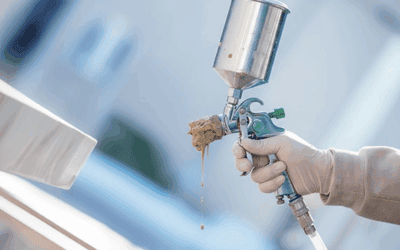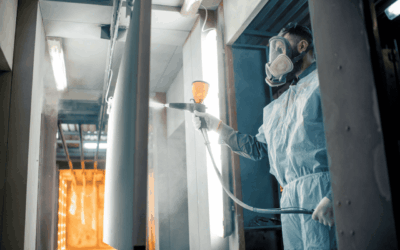Hazards of Spray Painting in Shipyards
Spray painting is integral to the marine industry, offering efficient application of protective coatings, but it comes with several health and safety risks that require stringent controls.
Understanding these risks and implementing the correct safety measures is critical to protecting workers’ health and ensuring safe operations.
Exposure to toxic fumes
One of the most significant spray painting hazards in shipyards is exposure to volatile organic compounds (VOCs), isocyanates, and other toxic chemicals. Prolonged inhalation can lead to respiratory issues, dizziness, headaches, and long-term health problems such as liver or kidney damage.
Effective ventilation is critical to reduce exposure, alongside the correct use of respirators with appropriate breathing filtration equipment to protect workers from inhaling hazardous fumes. For maximum safety, shipyards should also consider facilities with advanced airflow control, as well as high-quality breathing protection PPE.
Controlled space spray hazards
In the marine industry, spray painting typically occurs in controlled facilities such as spray booths, which are specifically designed to accommodate large ship components. While these spaces are controlled, they can still present hazards, so safety protocols are vital. Even with ventilation, spray fumes can accumulate if airflow is insufficient or systems are not properly maintained, increasing the risk of inhalation exposure. Overspray and poor ventilation can also create slippery surfaces or flammable atmospheres.
At Airblast Limited, our spray facilities are designed to maximise safety and efficiency, with advanced ventilation and containment systems to minimise exposure to hazardous fumes. Combined with our comprehensive range of spray equipment, we provide shipyards with the equipment and expertise needed to maintain the highest standards of spray painting safety. Choosing Airblast Limited ensures your team works in a safer, more controlled environment while achieving optimal coating results.
Fire and explosion hazards
Spray paints are often flammable, and the combination of paint fumes with heat sources or sparks can cause serious fires or explosion hazards. Shipyards should implement strict fire control measures, including eliminating ignition sources and ensuring ventilation prevents fume build-up. Providing employees with training and PPE is also critical to significantly reduce fire and explosion risks.
Skin and eye exposure
Paint overspray can irritate the skin and eyes, and direct contact may even cause burns or allergic reactions. Workers should always wear suitable personal protective equipment (PPE), including respirators, gloves, coveralls, and eye protection, to help prevent these injuries.
Mitigating spray painting hazards
A thorough risk assessment helps identify potential hazards associated with shipyards and spray painting operations and implement effective controls. This includes proper training of equipment, selecting appropriate spray equipment, and enforcing PPE use. By understanding the specific risks of shipyard spray painting and adopting comprehensive safety measures, employers can protect workers from harmful exposures while maintaining efficient operations.
Conclusion
Spray painting in shipyards is inherently hazardous, but with the right precautions, the risks can be managed effectively. By prioritising spray painting safety and adhering to ventilation and PPE protocols, shipyards can protect workers and maintain high operational standards.
At Airblast Limited, we help the marine industry improve spray painting safety with advanced spray facilities, ventilation systems, and a full range of PPE. Learn more about our spray facilities and PPE solutions to keep your workforce safe.



